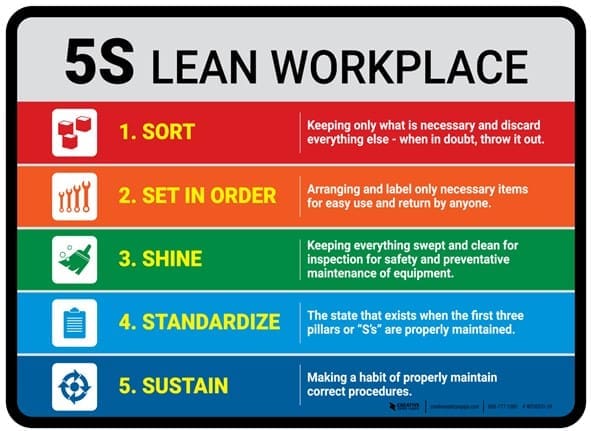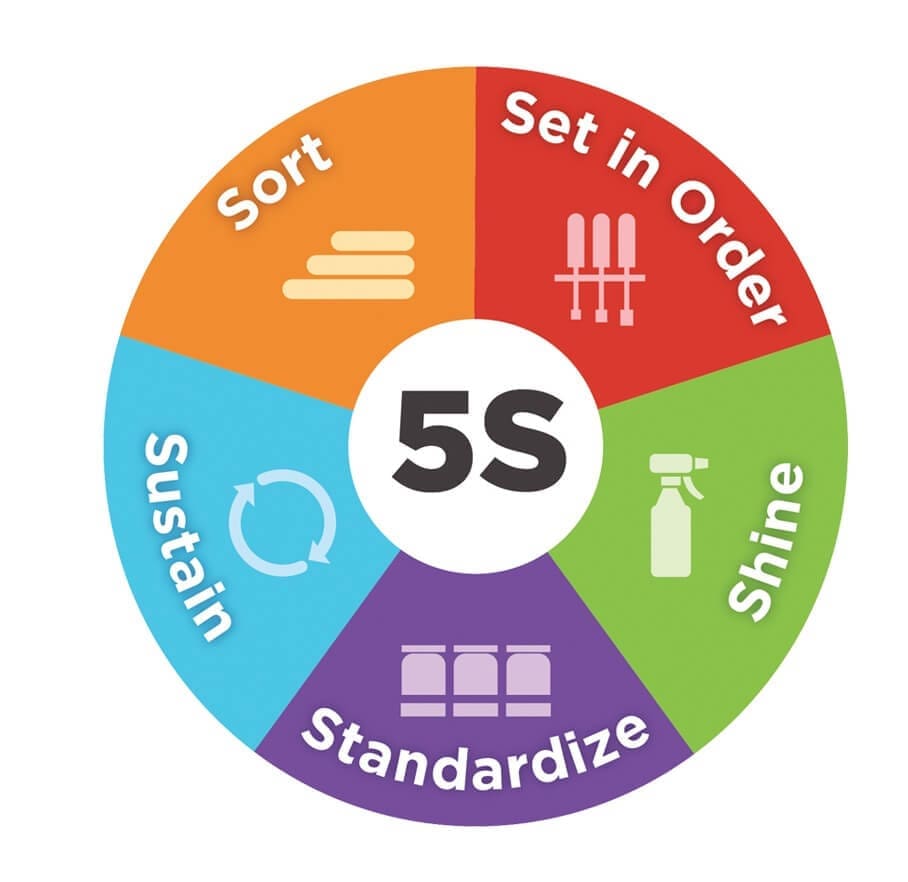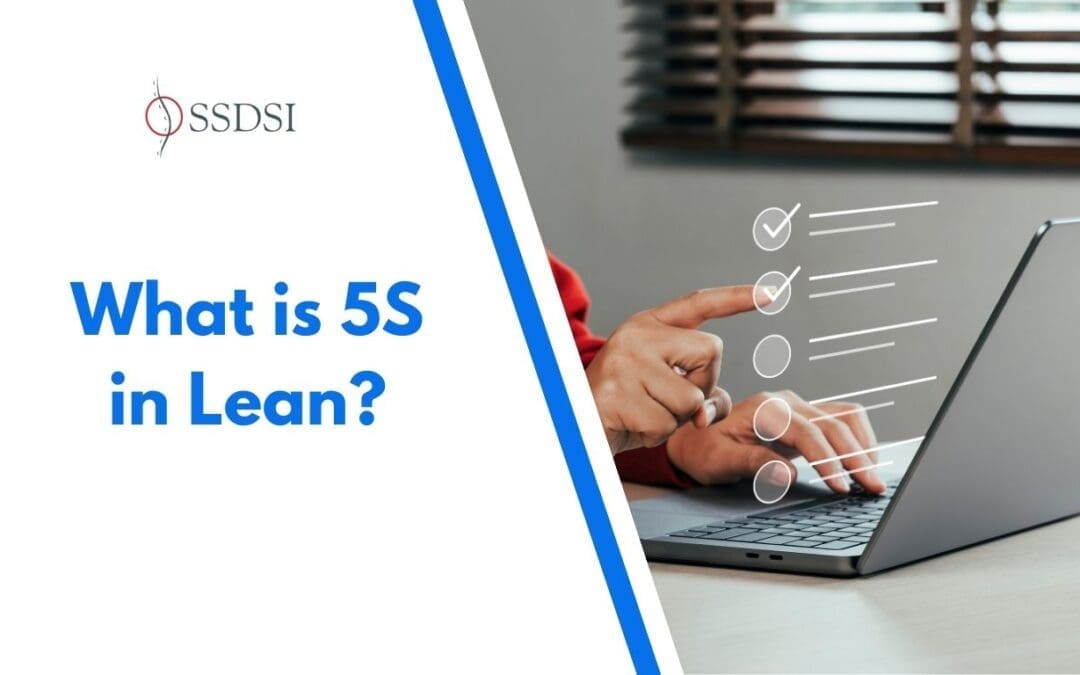Table of contents
- What is 5S in Lean?
- What Does 5S Mean?
- The Origin of LEAN 5S
- What is The Purpose of LEAN 5S?
- The Benefits of LEAN 5S
- The addition of a 6th “S”
- What does LEAN 5S have to do with Kaizen?
- LEAN 5S and the LEAN methodology
- LEAN 5S and Visual Management
- LEAN 5S and the Visual Workplace
- How do I get started?
- Related Articles
Estimated reading time: 8 minutes
What is 5S in Lean?
LEAN 5S is a formal methodology to create and sustain an efficient, visual workplace using 5 different steps each starting with the letter “S”. Implementing all 5S’ in a process allows the operators to work efficiently, effectively, and safely.
The term “5S” originates from five Japanese words that describe the key steps involved in this methodology. The 5S principles are Sort (Seiri), Set in Order (Seiton), Shine (Seiso), Standardize (Seiketsu), and Sustain (Shitsuke). When integrated with LEAN manufacturing, these principles become part of a broader strategy for continuous improvement and waste reduction.
What Does 5S Mean?

- Sort (or Seiri): Sort through all materials and keep only the necessary items for your tasks. This involves sorting through the entire contents of a workspace and deciding which items can be removed. Get rid of everything that you are not using to finish a task.
- Set in Order (or Seiton): Make sure that every item is organized and assigned a place. Workers will find it easier to organize all items in the workplace. It is important to place items in ergonomic places so that workers don’t have to bend or move around to reach them.
- Shine (or Seiso): To ensure that you can achieve your goals, make proactive efforts to maintain order and cleanliness in the workplace. It involves cleaning up and maintaining the new workspace. This could include routine tasks like mopping and dusting. It can also include the maintenance of machinery, tools, or other equipment.
- Standardize (or Seiketsu): Establish a set of standards for your organization and your processes. This is basically where you take the first three S’ and create rules that will govern how and when tasks are performed. These standards may include lists, charts, schedules, and so on.
- Sustain (or Shitsuke): To maintain discipline, you must continue to adopt new practices and conduct audits. The previous four S’ should be maintained over time. This can be achieved by instilling self-discipline in employees who are willing to participate in 5S.
The Origin of LEAN 5S
The origins of the 5S method can be traced back to post-war Japan where leaders of Toyota Industries were trying to reduce manufacturing waste and improve efficiency. The Toyota Production System was their solution. Although the Toyota Production System was initially kept secret, foreign companies widely knew it. They were curious about how Toyota, Japan’s most prestigious manufacturing company, managed to produce so many products at such high quality, in such a brief time. The five pillars were created by Hiroyuki Hirano, an executive at ULVAC Inc., and would eventually evolve into the 5S method as we know it today.
What is The Purpose of LEAN 5S?
The goal of 5S is to improve workplace efficiency and make it easier to work. This is achieved by making space make sense. Materials and tools are placed in logical places based on their use, frequency, and who they are needed. Regular cleaning is required. Organization and cleaning have become a habit. If 5S is used properly, it can make processes safer and more productive.
The Benefits of LEAN 5S

- Increased efficiency and reduced waste: The 5S system encourages companies to increase efficiency and reduce waste in their process. This will improve a company’s bottom line. This can be achieved by improving products and services and lowering costs.
- Optimized Organization: These five pillars are designed to reduce the time spent looking for, figuring out how to use, and returning items. Parts, tools, and information should be stored in a way that is easy to access and use.
- Increased Safety: “Waste” to be eliminated is defined broadly and includes everything from carrying excess inventory to waste of unsafe conditions – like a box of supplies left in a heavily trafficked area potentially causing a worker to trip and get injured.
- Larger Storage Density: Standard 5S implementation results in significant reductions in square footage required for existing operations. This system eliminates unnecessary items from production plants, allowing for more space to be used.
- Boosted workplace morale: The system’s main objective is to make it a routine to follow proper procedures and maintain discipline to prevent backsliding. This helps employees avoid disorganized, dark workplaces that can lead to lower morale.
The addition of a 6th “S”
The 6th “S” stands for Safety. To ensure safety is an integral part of their work practices, some businesses add this step to the end of 5S. Some businesses feel safety should be included in all steps of 5S. Safety plays a part in 5S. People can do their jobs more easily by organizing spaces in logical ways, organizing materials and tools, and cleaning frequently without falling, slipping, or injuring themselves.
What does LEAN 5S have to do with Kaizen?
Kaizen, a LEAN concept, refers to an ongoing process of “continuous improvements.” Kaizen is about finding small ways to improve processes throughout your organization. Kaizen works best when everyone at work participates in looking for ways to improve their tasks. These improvement ideas become improvement events. 5S should be an integral part of every Kaizen event.
LEAN 5S and the LEAN methodology

5S is an integral part of the LEAN Methodology. Implementing 5S at work makes it easier to find what you need and organize your workspace. Because the workplaces are conducive to LEAN with 5S implemented, initiatives like JIT, Flow / TAKT, Pull / Kanban, and other LEAN methods are easier to implement. Therefore, 5S is often called “the Gateway to improvement”.
LEAN 5S and Visual Management
Visual management is also known as visual control. It involves using visual signals to communicate key information. These visuals include photos, diagrams, color coding, and floor markings. This management style allows employees to quickly grasp the information being communicated. Visual management techniques can be used to make sure everyone understands the current state of work processes. A green or on light indicates that a process is running smoothly; a red light signals that there is a problem.
5S is a visual control system that emphasizes organization and can increase productivity. Workers can mark their storage areas with visual markings to help them return the materials to the right places. Floor markings can be used as boundaries to organize work cells. Signs on the floor can indicate the correct locations for recycling bins and trash cans. Visual tools such as these allow businesses to communicate information with workers without saying anything.
LEAN 5S and the Visual Workplace
Visual workplaces are places where people can use visual tools to obtain the information they need to do their job effectively. This visual explanation of the workplace reduces the need for questions from employees regarding process steps. Visual workplaces are often described as “self-explanatory, self-ordering and self-regulating,” because they use visual signals that allow them to function with minimal effort. An organization that uses 5S to make an organizational system visible is called a visual workplace.
How do I get started?
It can be daunting to start a project with the potential for major changes. There are several ways that you can help create rich soil to support your growth.
Employee buy-in is crucial to any 5S venture’s success. Employee buy-in simply means that employees are willing and able to contribute to the success of the 5S endeavor. Here are some ways to increase employee buy-in:
- Provide examples and a framework to help you succeed.
- Employee education
- Employees should be able to discuss potential pitfalls and barriers with one another.
- To help ease some of the uncertainties that may hinder the process, we will provide insight into how it will work.
Many teams will be excited and interested in discussing the potential pitfalls and obstacles associated with new changes during the employee buy-in process. Once the details have been worked out, valuable information and insight can be gained about how to approach the team in the future. Even the most daunting tasks can be overcome if you are positive and open to learning from them. Positive attitudes can be contagious.

About Six Sigma Development Solutions, Inc.
Six Sigma Development Solutions, Inc. offers onsite, public, and virtual Lean Six Sigma certification training. We are an Accredited Training Organization by the IASSC (International Association of Six Sigma Certification). We offer Lean Six Sigma Green Belt, Black Belt, and Yellow Belt, as well as LEAN certifications.
Book a Call and Let us know how we can help meet your training needs.












